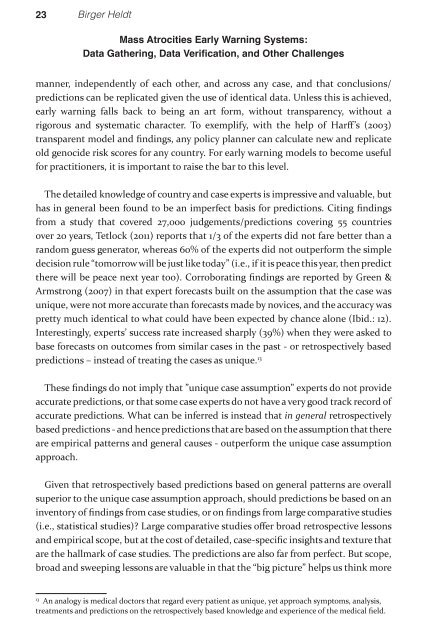GPANet-Report-2012
GPANet-Report-2012
GPANet-Report-2012
Create successful ePaper yourself
Turn your PDF publications into a flip-book with our unique Google optimized e-Paper software.
23 Birger Heldt<br />
Mass Atrocities Early Warning Systems:<br />
Data Gathering, Data Verification, and Other Challenges<br />
manner, independently of each other, and across any case, and that conclusions/<br />
predictions can be replicated given the use of identical data. Unless this is achieved,<br />
early warning falls back to being an art form, without transparency, without a<br />
rigorous and systematic character. To exemplify, with the help of Harff’s (2003)<br />
transparent model and findings, any policy planner can calculate new and replicate<br />
old genocide risk scores for any country. For early warning models to become useful<br />
for practitioners, it is important to raise the bar to this level.<br />
The detailed knowledge of country and case experts is impressive and valuable, but<br />
has in general been found to be an imperfect basis for predictions. Citing findings<br />
from a study that covered 27,000 judgements/predictions covering 55 countries<br />
over 20 years, Tetlock (2011) reports that 1/3 of the experts did not fare better than a<br />
random guess generator, whereas 60% of the experts did not outperform the simple<br />
decision rule “tomorrow will be just like today” (i.e., if it is peace this year, then predict<br />
there will be peace next year too). Corroborating findings are reported by Green &<br />
Armstrong (2007) in that expert forecasts built on the assumption that the case was<br />
unique, were not more accurate than forecasts made by novices, and the accuracy was<br />
pretty much identical to what could have been expected by chance alone (Ibid.: 12).<br />
Interestingly, experts’ success rate increased sharply (39%) when they were asked to<br />
base forecasts on outcomes from similar cases in the past - or retrospectively based<br />
predictions – instead of treating the cases as unique. 13<br />
These findings do not imply that ”unique case assumption” experts do not provide<br />
accurate predictions, or that some case experts do not have a very good track record of<br />
accurate predictions. What can be inferred is instead that in general retrospectively<br />
based predictions - and hence predictions that are based on the assumption that there<br />
are empirical patterns and general causes - outperform the unique case assumption<br />
approach.<br />
Given that retrospectively based predictions based on general patterns are overall<br />
superior to the unique case assumption approach, should predictions be based on an<br />
inventory of findings from case studies, or on findings from large comparative studies<br />
(i.e., statistical studies)? Large comparative studies offer broad retrospective lessons<br />
and empirical scope, but at the cost of detailed, case-specific insights and texture that<br />
are the hallmark of case studies. The predictions are also far from perfect. But scope,<br />
broad and sweeping lessons are valuable in that the “big picture” helps us think more<br />
13 An analogy is medical doctors that regard every patient as unique, yet approach symptoms, analysis,<br />
treatments and predictions on the retrospectively based knowledge and experience of the medical field.


